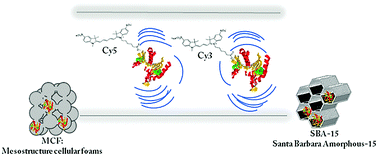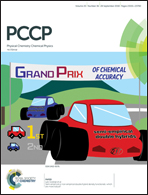Measuring viscosity inside mesoporous silica using protein-bound molecular rotor probe†
Abstract
Fluorescence spectroscopy of protein-bound molecular rotors Cy3 and Cy5 is used to monitor the effective viscosity inside the pores of two types of mesoporous silica (SBA-15 and MCF) with pore diameters between 8.9 and 33 nm. The ratio of the peak intensities is used to measure viscosity independently of solvent polarity, and the response of the lipase-bound dyes is calibrated using glycerol/water mixtures (no particles). The two dyes are either attached to the same protein or separate proteins in order to investigate potential effects of energy transfer (FRET) on the fluorescence properties, when using them as reporter dyes. The effective viscosity inside the pores at infinite protein dilution is one order of magnitude higher than in bulk water, and the effect of protein concentration on the measured viscosity indicates a stronger effect of protein–protein interactions in the pores than in similarly concentrated protein solutions without particles. In MCF-particles with octyl-groups covalently attached to the pore walls, a more efficient uptake of the lipase resulted in FRET between the protein-bound dyes even if the two dyes were attached to different proteins. In contrast to the unmodified particles the intensity-ratio method could therefore not be used to measure the viscosity, but the presence of FRET in itself indicates that octyl–protein interactions lead to a non-homogenous protein distribution in the pores. The dye labels also report a less polar pore environment as sensed by the proteins through a redshift in the dye emission. Both observations may help in understanding the higher efficiency of lipase immobilization in octyl-modified particles.



 Please wait while we load your content...
Please wait while we load your content...